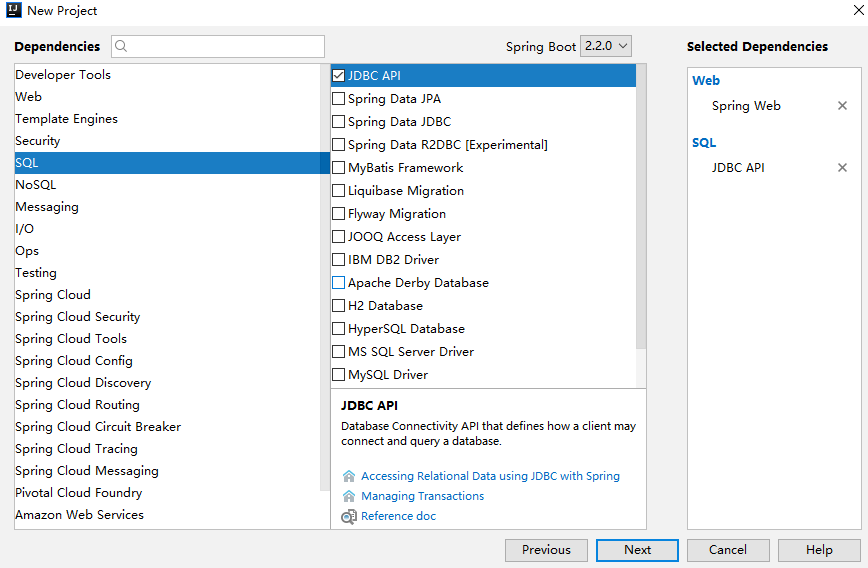Spring Boot2 系列教程(十九)Spring Boot 整合 JdbcTemplate
在 Java 领域,数据持久化有几个常见的方案,有 Spring 自带的 JdbcTemplate 、有 MyBatis,还有 JPA,在这些方案中,最简单的就是 Spring 自带的 JdbcTemplate 了,这个东西虽然没有 MyBatis 那么方便,但是比起最开始的 Jdbc 已经强了很多了,它没有 MyBatis 功能那么强大,当然也意味着它的使用比较简单,事实上,JdbcTemplate 算是最简单的数据持久化方案了,本文就和大伙来说说这个东西的使用。
1. 基本配置
JdbcTemplate 基本用法实际上很简单,开发者在创建一个 SpringBoot 项目时,除了选择基本的 Web 依赖,再记得选上 Jdbc 依赖,以及数据库驱动依赖即可,如下:
项目创建成功之后,记得添加 Druid 数据库连接池依赖(注意这里可以添加专门为 Spring Boot 打造的 druid-spring-boot-starter,而不是我们一般在 SSM 中添加的 Druid),所有添加的依赖如下:
<dependency>
<groupId>com.alibaba</groupId>
<artifactId>druid-spring-boot-starter</artifactId>
<version>1.1.10</version>
</dependency>
<dependency>
<groupId>org.springframework.boot</groupId>
<artifactId>spring-boot-starter-jdbc</artifactId>
</dependency>
<dependency>
<groupId>org.springframework.boot</groupId>
<artifactId>spring-boot-starter-web</artifactId>
</dependency>
<dependency>
<groupId>mysql</groupId>
<artifactId>mysql-connector-java</artifactId>
<version>5.1.27</version>
<scope>runtime</scope>
</dependency>
项目创建完后,接下来只需要在 application.properties 中提供数据的基本配置即可,如下:
spring.datasource.type=com.alibaba.druid.pool.DruidDataSource
spring.datasource.username=root
spring.datasource.password=123
spring.datasource.url=jdbc:mysql:///test01?useUnicode=true&characterEncoding=UTF-8
如此之后,所有的配置就算完成了,接下来就可以直接使用 JdbcTemplate 了?咋这么方便呢?其实这就是 SpringBoot 的自动化配置带来的好处,我们先说用法,一会来说原理。
2. 基本用法
首先我们来创建一个 User Bean,如下:
public class User {
private Long id;
private String username;
private String address;
//省略getter/setter
}
然后来创建一个 UserService 类,在 UserService 类中注入 JdbcTemplate ,如下:
@Service
public class UserService {
@Autowired
JdbcTemplate jdbcTemplate;
}
好了,如此之后,准备工作就算完成了。
2.1 增
JdbcTemplate 中,除了查询有几个 API 之外,增删改统一都使用 update 来操作,自己来传入 SQL 即可。例如添加数据,方法如下:
public int addUser(User user) {
return jdbcTemplate.update("insert into user (username,address) values (?,?);", user.getUsername(), user.getAddress());
}
update 方法的返回值就是 SQL 执行受影响的行数。
这里只需要传入 SQL 即可,如果你的需求比较复杂,例如在数据插入的过程中希望实现主键回填,那么可以使用 PreparedStatementCreator,如下:
public int addUser2(User user) {
KeyHolder keyHolder = new GeneratedKeyHolder();
int update = jdbcTemplate.update(new PreparedStatementCreator() {
@Override
public PreparedStatement createPreparedStatement(Connection connection) throws SQLException {
PreparedStatement ps = connection.prepareStatement("insert into user (username,address) values (?,?);", Statement.RETURN_GENERATED_KEYS);
ps.setString(1, user.getUsername());
ps.setString(2, user.getAddress());
return ps;
}
}, keyHolder);
user.setId(keyHolder.getKey().longValue());
System.out.println(user);
return update;
}
实际上这里就相当于完全使用了 JDBC 中的解决方案了,首先在构建 PreparedStatement 时传入 Statement.RETURN_GENERATED_KEYS,然后传入 KeyHolder,最终从 KeyHolder 中获取刚刚插入数据的 id 保存到 user 对象的 id 属性中去。
你能想到的 JDBC 的用法,在这里都能实现,Spring 提供的 JdbcTemplate 虽然不如 MyBatis,但是比起 Jdbc 还是要方便很多的。
2.2 删
删除也是使用 update API,传入你的 SQL 即可:
public int deleteUserById(Long id) {
return jdbcTemplate.update("delete from user where id=?", id);
}
当然你也可以使用 PreparedStatementCreator。
2.3 改
public int updateUserById(User user) {
return jdbcTemplate.update("update user set username=?,address=? where id=?", user.getUsername(), user.getAddress(),user.getId());
}
当然你也可以使用 PreparedStatementCreator。
2.4 查
查询的话,稍微有点变化,这里主要向大伙介绍 query 方法,例如查询所有用户:
public List<User> getAllUsers() {
return jdbcTemplate.query("select * from user", new RowMapper<User>() {
@Override
public User mapRow(ResultSet resultSet, int i) throws SQLException {
String username = resultSet.getString("username");
String address = resultSet.getString("address");
long id = resultSet.getLong("id");
User user = new User();
user.setAddress(address);
user.setUsername(username);
user.setId(id);
return user;
}
});
}
查询的时候需要提供一个 RowMapper,就是需要自己手动映射,将数据库中的字段和对象的属性一一对应起来,这样。。。。嗯看起来有点麻烦,实际上,如果数据库中的字段和对象属性的名字一模一样的话,有另外一个简单的方案,如下:
public List<User> getAllUsers2() {
return jdbcTemplate.query("select * from user", new BeanPropertyRowMapper<>(User.class));
}
至于查询时候传参也是使用占位符,这个和前文的一致,这里不再赘述。
2.5 其他
除了这些基本用法之外,JdbcTemplate 也支持其他用法,例如调用存储过程等,这些都比较容易,而且和 Jdbc 本身都比较相似,这里也就不做介绍了,有兴趣可以留言讨论。
3. 原理分析
那么在 SpringBoot 中,配置完数据库基本信息之后,就有了一个 JdbcTemplate 了,这个东西是从哪里来的呢?源码在 org.springframework.boot.autoconfigure.jdbc.JdbcTemplateAutoConfiguration 类中,该类源码如下:
@Configuration
@ConditionalOnClass({ DataSource.class, JdbcTemplate.class })
@ConditionalOnSingleCandidate(DataSource.class)
@AutoConfigureAfter(DataSourceAutoConfiguration.class)
@EnableConfigurationProperties(JdbcProperties.class)
public class JdbcTemplateAutoConfiguration {
@Configuration
static class JdbcTemplateConfiguration {
private final DataSource dataSource;
private final JdbcProperties properties;
JdbcTemplateConfiguration(DataSource dataSource, JdbcProperties properties) {
this.dataSource = dataSource;
this.properties = properties;
}
@Bean
@Primary
@ConditionalOnMissingBean(JdbcOperations.class)
public JdbcTemplate jdbcTemplate() {
JdbcTemplate jdbcTemplate = new JdbcTemplate(this.dataSource);
JdbcProperties.Template template = this.properties.getTemplate();
jdbcTemplate.setFetchSize(template.getFetchSize());
jdbcTemplate.setMaxRows(template.getMaxRows());
if (template.getQueryTimeout() != null) {
jdbcTemplate
.setQueryTimeout((int) template.getQueryTimeout().getSeconds());
}
return jdbcTemplate;
}
}
@Configuration
@Import(JdbcTemplateConfiguration.class)
static class NamedParameterJdbcTemplateConfiguration {
@Bean
@Primary
@ConditionalOnSingleCandidate(JdbcTemplate.class)
@ConditionalOnMissingBean(NamedParameterJdbcOperations.class)
public NamedParameterJdbcTemplate namedParameterJdbcTemplate(
JdbcTemplate jdbcTemplate) {
return new NamedParameterJdbcTemplate(jdbcTemplate);
}
}
}
从这个类中,大致可以看出,当当前类路径下存在 DataSource 和 JdbcTemplate 时,该类就会被自动配置,jdbcTemplate 方法则表示,如果开发者没有自己提供一个 JdbcOperations 的实例的话,系统就自动配置一个 JdbcTemplate Bean(JdbcTemplate 是 JdbcOperations 接口的一个实现)。好了,不知道大伙有没有收获呢?
本文案例,我已经上传到 GitHub:https://github.com/lenve/javaboy-code-samples
·······················
欢迎关注专栏:
《Spring Cloud微服务开发实践》
共同学习,写下你的评论
评论加载中...
作者其他优质文章





